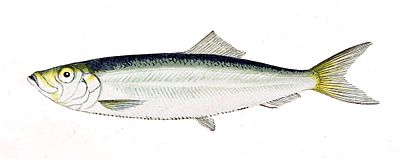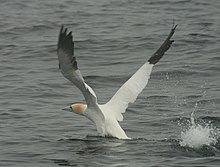Sprat
Sprat is the common name applied to a group of forage fish belonging to the genus Sprattus in the family Clupeidae.
The term also is applied to a number of other small sprat-like forage fish (Clupeoides, Clupeonella, Corica, Ehirava, Hyperlophus, Microthrissa, Nannothrissa, Platanichthys, Ramnogaster, Rhinosardinia, and Stolothrissa).
Some examples are: The average length of time from fertilization to hatching is about 15 days, with environmental factors playing a major role in the size and overall success of the sprat.
In recent decades the number of sprat has fluctuated, due primarily to availability of zooplankton, a common food source, and also from overall changes in Clupeidae total abundance.
[24] Recent studies suggesting a progression in the reproductive success of the sprat acknowledge that a significant increase in spawning stock biomass occurred.
The Baltic Sea provides the sprat with a highly diverse environment, with spatial and temporal potential allowing for successful reproduction.
[24] Pseudocalanus is genus of the order Calanoida and subclass Copepoda that is important to the predation and diet of fish in the Baltic Sea.
[24] In Northern Europe, European sprats are commonly smoked and preserved in oil, which retains a strong, smoky flavor.
They are present in amounts comparable to Atlantic salmon, and up to seven times higher in EPA and DHA than common fresh fillets of gilt-head bream.



